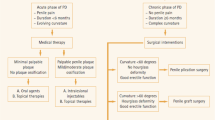Abstract
Peyronie's disease is a medically and surgically challenging condition to manage. Most surgical techniques to correct the penile deformity often shorten the penis and do not address the issue of hourglass deformity when present. We describe our indications, rationale and technique for the use of a saphenous vein graft after a curvature correcting plaque incision. In reviewing multiple series, this approach yields similar results–incidence of residual curvature: 4–20%, decreased potency: 5–20%, penile shortening: 17–40%. While harvesting the vein would require a second incision, the use of autologous vein appears to be associated with the least amount of intracavernosal fibrosis. We propose that saphenous vein is currently the best material available for tunical patching. The technique and results of circular venous grafting for patients with severe penile shortening secondary to Peyronie's disease is also discussed.
This is a preview of subscription content, access via your institution
Access options
Subscribe to this journal
Receive 8 print issues and online access
$259.00 per year
only $32.38 per issue
Buy this article
- Purchase on Springer Link
- Instant access to full article PDF
Prices may be subject to local taxes which are calculated during checkout

Similar content being viewed by others
References
Ralph DJ, Al-Akraa M, Pryor J . The Nesbit operation for Peyronie's disease: 16-year experience J Urol 1995 154: 1362–1363
Poulsen J, Kirkeby HJ . Treatment of penile curvature—a retrospective study of 175 patients operated with plication of the tunica albuginea or with the Nesbit procedure Br J Urol 1995 75: 370–374
Lue TF, El-Sakka AI . Venous patch graft for Peyronie's disease. Part I: technique J Urol 1998 160: 2047–2049
Gholami SS, Lue TF . Peyronie's disease Urol Clin N Am 2001 28: 377–390
El-Sakka AI, Rashwan HM, Lue TF . Venous patch graft for Peyronie's disease. Part II: outcome analysis J Urol 1998 160: 2050–2053
Brannigan RE, Kim ED, Oyasu R, McVary KT . Comparison of tunica albuginea substitutes for the treatment of Peyronie's disease J Urol 1998 159: 1064
Montorsi F et al. Evidence based assessment of long-term results of plaque incision and vein grafting for Peyronie's disease J Urol 2000 163: 1704–1708
Ralph DJ . What's new in Peyronie's disease? Curr Opin Urol 1999 9: 569–571
Akkus E et al. Incisional venous patch in Peyronie's disease Int J Impot Res 1998 10: (Suppl3) A480 S66
Kadioglu A . Surgical treatment of Peyronie's disease with incision and venous patch technique Int J Impot Res 1999 11: 75–81
Lue TF, El-Sakka AI . Lengthening shortened penis caused by Peyronie's disease using circular venous grafting and daily stretching with a vacuum erection device J Urol 1999 161: 1141–1144
Friedman HE, Levitz S . A literature review of the Ilizarov technique and some applications for treating foot pathology J Foot Ankle Surg 1994 33: 30
Wessells H, Lue TF, McAninch JW . Complications of penile lengthening and augmentation seen at one referral center J Urol 1996 155: 1617–1620
Author information
Authors and Affiliations
Corresponding author
Rights and permissions
About this article
Cite this article
Chang, J., Gholami, S. & Lue, T. Surgical management: saphenous vein grafts. Int J Impot Res 14, 375–378 (2002). https://doi.org/10.1038/sj.ijir.3900862
Received:
Accepted:
Published:
Issue Date:
DOI: https://doi.org/10.1038/sj.ijir.3900862



